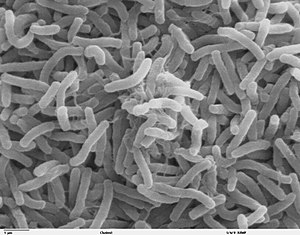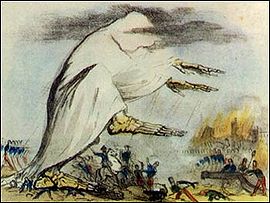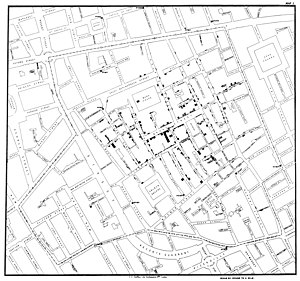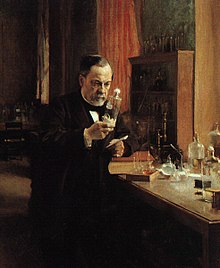Germ theory of disease

The germ theory of disease states that some infectious diseases are caused by microorganisms. These small organisms, too small to see without magnification, invade humans, animals, and other living hosts. Their growth and reproduction within bodies can cause a disease. "Germ" may refer to a virus, bacterium, fungus, or prion, and microorganisms that cause disease are called pathogens.
The germ theory was a scientific discovery of the later 19th century. It supplanted earlier explanations for disease, such as miasma theory.
Miasma theory

The miasma theory of disease transmission held that diseases such as cholera, chlamydia or the Black Death were caused by a miasma (μίασμα, ancient Greek: "pollution"), a noxious form of "bad air". The theory held that the origin of these epidemic diseases was a miasma, emanating from rotting organic matter.[1] Miasma was considered to be a poisonous vapor or mist filled with particles from decomposed matter (miasmata) that caused illnesses. The miasmatic position was that diseases were the product of environmental factors such as contaminated water, foul air, and poor hygienic conditions. Such infection was not passed between individuals but would affect individuals within the locale that gave rise to such vapors. It was identifiable by its foul smell.
This was the predominant theory of disease transmission before the germ theory of disease took hold in the 19th century.
Development
Pre-19th century
Girolamo Fracastoro proposed in 1546 that epidemic diseases are caused by transferable seed-like entities that transmit infection by direct or indirect contact, or even without contact over long distances.
Italian physician Francesco Redi provided early evidence against spontaneous generation. He devised an experiment in 1668 in which he used three jars. He placed a meatloaf and egg in each of the three jars. He had one of the jars open, another one tightly sealed, and the last one covered with gauze. After a few days, he observed that the meat loaf in the open jar was covered by maggots, and the jar covered with gauze had maggots on the surface of the gauze. However, the tightly sealed jar had no maggots inside or outside it. He also noticed that the maggots were found only on surfaces that were accessible by flies. From this he concluded that spontaneous generation is not a plausible theory.
Microorganisms were first directly observed by Anton van Leeuwenhoek, who was an early pioneer in microbiology. Building on Leeuwenhoek's work, physician Nicolas Andry argued in 1700 that microorganisms he called "worms" were responsible for smallpox and other diseases.[2]
Agostino Bassi
The Italian Agostino Bassi was the first person to prove that a disease was caused by a microorganism when he conducted a series of experiments between 1808 and 1813, demonstrating that a "vegetable parasite" caused a disease in silkworms known as calcinaccio. This disease was devastating the French silk industry at the time. The "vegetable parasite" is now known to be a fungus pathogenic to insects called Beauveria bassiana (named after Bassi).
Ignaz Semmelweis
Ignaz Semmelweis was a Hungarian obstetrician working at the Vienna General Hospital (Allgemeines Krankenhaus) in 1847, when he noticed the dramatically high incidence of death from puerperal fever among women who delivered at the hospital with the help of the doctors and medical students. Births attended by the midwives were relatively safe. Investigating further, Semmelweis made the connection between puerperal fever and examinations of delivering women by doctors, and further realized that these physicians had usually come directly from autopsies. Asserting that puerperal fever was a contagious disease and that matter from autopsies were implicated in its development, Semmelweis made doctors wash their hands with chlorinated lime water before examining pregnant women, thereby reducing mortality from childbirth from 18% to 2.2% at his hospital. Nevertheless, he and his theories were at first rejected by most of the Viennese medical establishment.
John Snow

John Snow was a skeptic of the then-dominant miasma theory. The germ theory of disease had not yet been developed, so Snow did not understand the mechanism by which the disease was transmitted. He first published his theory in an 1849 essay On the Mode of Communication of Cholera. Despite continuing reports,[3] he was awarded 30,000 French francs for this work by the Institut de France.[4] In 1855 he published a second edition of his article, documenting his more elaborate investigation of the effect of the water supply in the Soho, London epidemic of 1854.
By talking to local residents, he identified the source of the outbreak as the public water pump on Broad Street (now Broadwick Street). Although Snow's chemical and microscope examination of a water sample from the Broad Street pump did not conclusively prove its danger, his studies of the pattern of the disease were convincing enough to persuade the local council to disable the well pump by removing its handle. This action has been commonly credited as ending the outbreak, but Snow observed that the epidemic may have already been in rapid decline.[5]
Snow later used a dot map to illustrate the cluster of cholera cases around the pump. He also used statistics to illustrate the connection between the quality of the water source and cholera cases. He showed that the Southwark and Vauxhall Waterworks Company was taking water from sewage-polluted sections of the Thames and delivering the water to homes, leading to an increased incidence of cholera. Snow's study was a major event in the history of public health and geography. It is regarded as one of the founding events of the science of epidemiology.
Later, researchers discovered that this public well had been dug only three feet from an old cesspit, which had begun to leak fecal bacteria.[citation needed] The nappies of a baby, who had contracted cholera from another source, had been washed into this cesspit. Its opening was originally under a nearby house, which had been rebuilt farther away after a fire. The city had widened the street and the cesspit was lost. It was common at the time to have a cesspit under most homes. Most families tried to have their raw sewage collected and dumped in the Thames to prevent their cesspit from filling faster than the sewage could decompose into the soil.
After the cholera epidemic had subsided, government officials replaced the handle on the Broad Street pump. They had responded only to the urgent threat posed to the population, and afterward they rejected Snow's theory. To accept his proposal would have meant indirectly accepting the oral-fecal method transmission of disease, which they dismissed as "too depressing." [6]
Louis Pasteur

The more formal experiments on the relationship between germ and disease were conducted by Louis Pasteur between 1860 and 1864. He discovered the pathology of the puerperal fever[7] and the pyogenic vibrio in the blood, and suggest using boric acid to kill these microorganisms before and after confinement.
Pasteur further demonstrated between 1860 and 1864 that fermentation and the growth of microorganisms in nutrient broths did not proceed by spontaneous generation. He exposed freshly boiled broth to air in vessels that contained a filter to stop all particles passing through to the growth medium: and even with no filter at all, with air being admitted via a long tortuous tube that would not pass dust particles. Nothing grew in the broths, therefore the living organisms that grew in such broths came from outside, as spores on dust, rather than being generated within the broth.
Pasteur discovered that another serious disease of silkworms, pebrine, was caused by a small microscopic organism now known as Nosema bombycis (1870). Pasteur saved the silk industry in France by developing a method to screen silkworms eggs for those that are not infected, a method that is still used today to control this and other silkworm diseases.
Robert Koch
Robert Koch is known for developing four basic criteria (known as Koch's Postulates) for demonstrating, in a scientifically sound manner, that a disease is caused by a particular organism. These postulates grew out of his seminal work with anthrax using purified cultures of the pathogen that had been isolated from diseased animals.
Koch's postulates were developed in the 19th century as general guidelines to identify pathogens that could be isolated with the techniques of the day.[8] Even in Koch's time, it was recognized that some infectious agents were clearly responsible for disease even though they did not fulfill all of the postulates.[9][10] Attempts to rigidly apply Koch's postulates to the diagnosis of viral diseases in the late 19th century, at a time when viruses could not be seen or isolated in culture, may have impeded the early development of the field of virology.[11][12] Currently, a number of infectious agents are accepted as the cause of disease despite their not fulfilling all of Koch's postulates.[13] Therefore, while Koch's postulates retain historical importance and continue to inform the approach to microbiologic diagnosis, fulfillment of all four postulates is not required to demonstrate causality.
Koch's postulates have also influenced scientists who examine microbial pathogenesis from a molecular point of view. In the 1980s, a molecular version of Koch's postulates was developed to guide the identification of microbial genes encoding virulence factors.[14]
Koch's postulates are the following:
- The microorganism must be found in abundance in all organisms suffering from the disease, but should not be found in healthy organisms.
- The microorganism must be isolated from a diseased organism and grown in pure culture.
- The cultured microorganism should cause disease when introduced into a healthy organism.
- The microorganism must be reisolated from the inoculated, diseased experimental host and identified as being identical to the original specific causative agent.
However, Koch abandoned the universalist requirement of the first postulate altogether when he discovered asymptomatic carriers of cholera[15] and, later, of typhoid fever. Asymptomatic or subclinical infection carriers are now known to be a common feature of many infectious diseases, especially viruses such as polio, herpes simplex, HIV, and hepatitis C. As a specific example, all doctors and virologists agree that poliovirus causes paralysis in just a few infected subjects, and the success of the polio vaccine in preventing disease supports the conviction that the poliovirus is the causative agent.
The third postulate specifies "should", not "must", because as Koch himself proved in regard to both tuberculosis and cholera,[9] not all organisms exposed to an infectious agent will acquire the infection. Noninfection may be due to such factors as general health and proper immune functioning; acquired immunity from previous exposure or vaccination; or genetic immunity, as with the resistance to malaria conferred by possessing at least one sickle cell allele.
The second postulate may also be suspended for certain microorganisms or entities that cannot (at the present time) be grown in pure culture, such as prions responsible for Creutzfeldt–Jakob disease.[16] In summary, a body of evidence that satisfies Koch's postulates is sufficient but not necessary to establish causation.
Sanitation
In the 1870s, Joseph Lister was instrumental in developing practical applications of the germ theory of disease with respect to sanitation in medical settings and aseptic surgical techniques—partly through the use of carbolic acid (phenol) as an antiseptic. Simultaneous innovations in medical sanitation were developed independently by Ignaz Semmelweis.
See also
- Epidemiology
- Cell theory
- Germ theory denialism
- Alexander Fleming
- Robert Hooke
- Rudolf Virchow
- Zymotic disease
References
- ^ John M. Last, ed. (2007). "A Dictionary of Public Health". Westminster College, Pennsylvania: Oxford University Press.
{{cite web}}:|contribution=ignored (help) - ^ "The History of the Germ Theory". The British Medical Journal. 1 (1415): 312. 1888.
- ^ S. William Gunn, M. Masellis (2008). Concepts and practice of humanitarian medicine. ISBN 0-387-72263-7. [1]
- ^ Couvrier R, Edwards G (July 1959). "John Snow and the Institute of France". Med Hist. 3 (3): 249–251. PMC 1034490.
- ^ John Snow (1849). On the Mode of Communication of Cholera. London: J. Churchill.
There is no doubt that the mortality was much diminished, as I said before, by the flight of the population, which commenced soon after the outbreak; but the attacks had so far diminished before the use of the water was stopped, that it is impossible to decide whether the well still contained the cholera poison in an active state, or whether, from some cause, the water had become free from it
- ^ Chapelle, Frank (2005). "Ch. 5: Hidden Life, Hidden Death". Wellsprings. New Brunswick NJ: Rutgers University Press. p. 82. ISBN 9780813536149.
{{cite book}}: External link in|chapterurl=|chapterurl=ignored (|chapter-url=suggested) (help) - ^ Pasteur, Louis (1880) [May 1880]. "(translated from French)". Comptes rendus, de l’Academie des Sciences. Vol. XC. Ernst, H.C. (trans). pp. 1033–44.
{{cite book}}: External link in|chapterurl=|chapterurl=ignored (|chapter-url=suggested) (help); Unknown parameter|trans_chapter=ignored (|trans-chapter=suggested) (help) - ^ Walker L, Levine H, Jucker M (2006). "Koch's postulates and infectious proteins". Acta Neuropathol (Berl). 112 (1): 1–4. doi:10.1007/s00401-006-0072-x. PMID 16703338.
{{cite journal}}: CS1 maint: multiple names: authors list (link) - ^ a b Koch Robert (1884). "2 Die Aetiologie der Tuberkulose". Mittheilungen aus dem Kaiserlichen Gesundheitsamt. pp. 1–88.
- ^ Koch R (1893). "Ueber den augenblicklichen Stand der bakteriologischen Choleradiagnose". J. Hyg. Inf. 14: 319–33. doi:10.1007/BF02284324.
- ^ Brock TD (1999). Robert Koch: a life in medicine and bacteriology. Washington DC: American Society of Microbiology Press. ISBN 1-55581-143-4.
- ^ Evans AS (1976). "Causation and disease: the Henle-Koch postulates revisited". Yale J Biol Med. 49 (2): 175–95. PMC 2595276. PMID 782050.
{{cite journal}}: Unknown parameter|month=ignored (help) - ^ Jacomo V, Kelly P, Raoult D (2002). "Natural history of Bartonella infections (an exception to Koch's postulate)". Clin Diagn Lab Immunol. 9 (1): 8–18. doi:10.1128/CDLI.9.1.8-18.2002. PMC 119901. PMID 11777823.
{{cite journal}}: CS1 maint: multiple names: authors list (link) - ^ Falkow S (1988). "Molecular Koch's postulates applied to microbial pathogenicity". Rev. Infect. Dis. 10 (Suppl 2): S274–6. PMID 3055197.
- ^ Koch Robert (1893). "Über den augenblicklichen Stand der bakteriologischen Choleradiagnose". Zeitschrift für Hygiene und Infectionskrankheiten (in German). 14: 319–333. doi:10.1007/BF02284324.
- ^ Inglis TJ (2007). "Principia aetiologica: taking causality beyond Koch's postulates". J. Med. Microbiol. 56 (Pt 11): 1419–22. doi:10.1099/jmm.0.47179-0. PMID 17965339.
{{cite journal}}: Unknown parameter|month=ignored (help)
External links
- Stephen T. Abedon Germ Theory of Disease Supplemental Lecture (98/03/28 update)
- William C. Campbell The Germ Theory Calendar
- Science's war on infectious diseases
